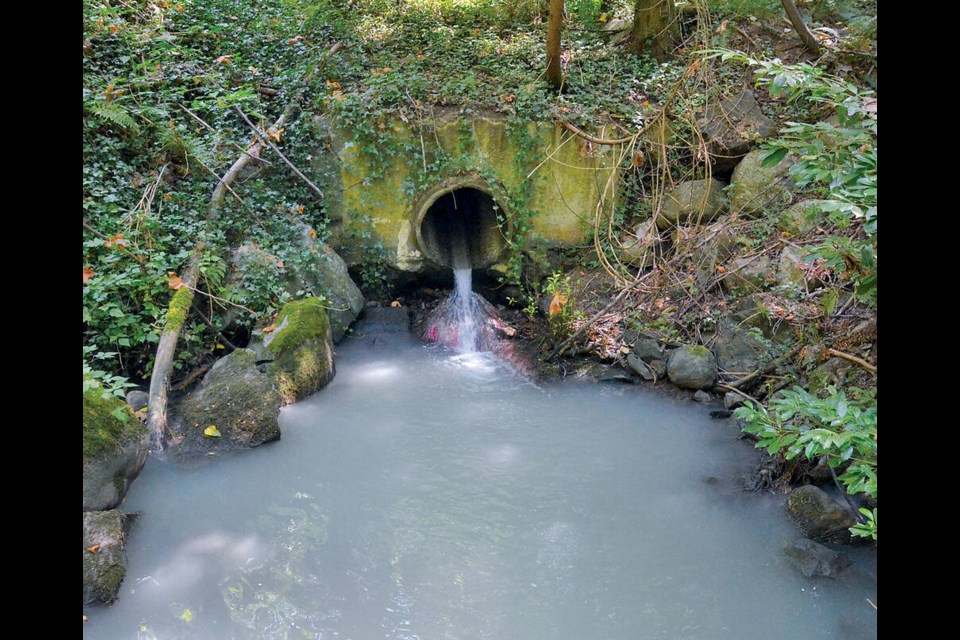North Shore streamkeepers say having signs at local creeks telling the public who to call when they spot a spill would go a long way to being able to nab pollution at the source.
Carolyn Robertson, vice-president of the North Shore Streamkeepers, made the comments after local dog walkers spotted a white milky substance draining into North Vancouver’s Wagg Creek from a storm drain on Friday and flowing downstream for several hours.
But by the time city officials were alerted and went to investigate, the spill had already washed through the creek.
That’s unfortunate because “it’s difficult to identify once it’s washed out of the immediate area,” said Robertson.
Robertson said officials count on the public to let them know when anything’s amiss.
“They are our eyes and ears,” she said. “It would be really great it there was some signage that told folks where to call.”
James Smith said he was walking his dog near the creek on Friday morning in the vicinity of the Fell Street Armoury when he was approached by another dog walker warning him not to let his dog go into the water.
Smith said he could see something grey or whitish coloured draining from the uphill outfall pipe. “It was the only colour of water that was coming through that pipe,” he said. Smith speculated the substance could have been paint mixed with water or concrete, but added at the time, the area had not had any rain “so it wouldn’t have been storm drain runoff.”
“It’s normally a really clean place,” he said, noted for its wildlife values and spawning salmon habitat.
Smith said he took photos of the stream and posted them on social media but didn’t call anyone to make a report.
A few hours later, a North Shore News photographer also snapped photos of the substance spilling into the creek.
But by the time City of North Vancouver crews went to investigate a short time later, all signs of the spill were gone.
The same was true when Robertson went to investigate that evening.
“It had already made its way down to the bottom,” she said.
Catchment has history of spills
The catchment feeding into that drain is a large one, she added, going all the way over to Moody Avenue along 15th Street and up to 20th Street on the north. “I’ve had people comment to me it often has a strong greywater or chemically smell,” she said. “There’s been soap washing out of there in the past.”
The outfall itself contains evidence of past paint spills, she added.
A spill of concrete wash would be especially concerning because it’s highly toxic and has led to fish kills in other North Shore creeks, she said.
“If it was a high enough concentration, it would kill whatever fish are in there.”
Not all spills are deliberate, Robertson added. If the spill went on for several hours, it was likely caused by some kind of “extended rinsing” activity, she said – like pressure washing of concrete, for instance.
Streamkeepers launch water quality monitoring project
In an effort to nail down what is entering local creeks, North Shore Streamkeepers is embarking on a storm water quality monitoring program, which will involve gathering samples from stormwater pipes during times when significant rainfall happens following a period of drought.
Research shows the concentration of pollutants that gets washed into local streams is higher during those “first flush” conditions than at other times, said Robertson.
“It’s been known for a long time that heavy metals and all sorts of vehicle dust also accumulates on the road” then gets washed into local streams, she said. That includes the chemical 6PPD-Q, the tire toxin that is deadly to coho in tiny concentrations, as well as more common roadway pollution, which all “gets washed as a deadly soupl into creeks when it rains,” she said.
Streamkeepers is working with environmental consultants to prioritize the outfalls for sampling, said Robertson, based on size and location of the catchment area.
“Urban runoff is one of the major threats to salmonids right now,” she said.
The first phase will involve sampling water from among the over 10 stormwater outfalls on Wagg Creek during “first flush” rainfall events. In the second phase, volunteers hope to narrow down the outfalls to those which are most concerning and send water samples for chemical analysis in a lab.
“Wagg Creek is a major tributary of Mosquito Creek,” she said. “It’s a super stressed creek and it’s not in good health.”
Later on, Streamkeepers hope to use the information to advocate for mitigation measures such as use of swales to absorb runoff before it gets dumped into the creeks.
Robertson urges anyone who does see spills happening to call the municipality, adding local governments are required to treat spills into fish-bearing habitat as emergencies.
She also urges people to take a sample where possible – even if it’s just in a Ziplock bag.
In the interim, Robertson said she hopes municipalities will consider better signage – which could even include a QR code – so people know what to do.




